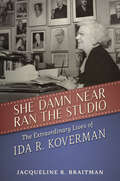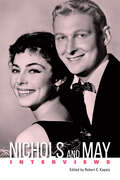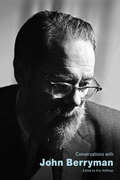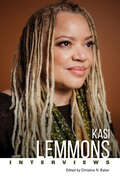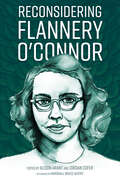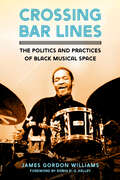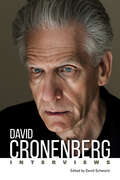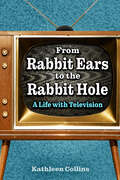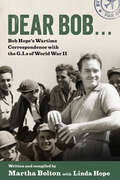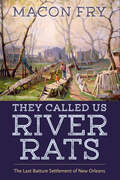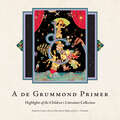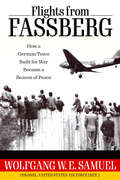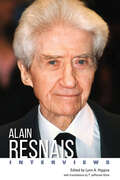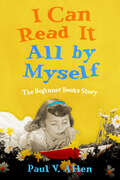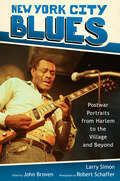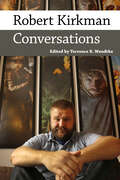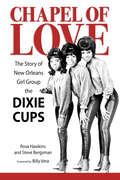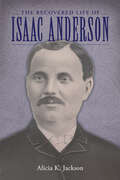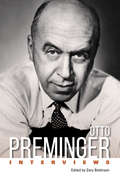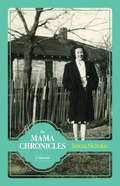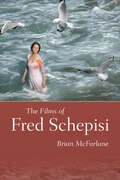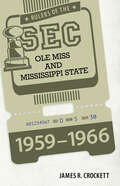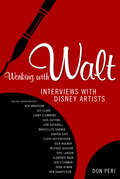- Table View
- List View
She Damn Near Ran the Studio: The Extraordinary Lives of Ida R. Koverman (Hollywood Legends Series)
by Jacqueline R. BraitmanBest known as the woman who “ran MGM,” Ida R. Koverman (1876–1954) served as talent scout, mentor, executive secretary, and confidant to American movie mogul Louis B. Mayer for twenty-five years. She Damn Near Ran the Studio: The Extraordinary Lives of Ida R. Koverman is the first full account of Koverman’s life and the true story of how she became a formidable politico and a creative powerhouse during Hollywood’s Golden Era. For nearly a century, Koverman’s legacy has largely rested on a mythical narrative while her more fascinating true-life story has remained an enduring mystery—until now. This story begins with Koverman’s early years in Ohio and the sensational national scandal that forced her escape to New York where she created a new identity and became a leader among a community of women. Her second incarnation came in California where she established herself as a hardcore political operative challenging the state’s progressive impulse. During the Roaring Twenties, she was a key architect of the Southland’s conservative female-centric partisan network that refashioned the course of state and national politics and put Herbert Hoover in the White House. As “the political boss of Los Angeles County,” she was the premiere matchmaker in the courtship between Hollywood and national partisan politics, which, as Mayer’s executive secretary, was epitomized by her third incarnation as “one of the most formidable women in Hollywood,” whose unparalleled power emanated from her unique perch inside the executive suite of Metro-Goldwyn-Mayer. Free to adapt her managerial skills and political know-how on behalf of the studio, she quickly drew upon her artistic sensibilities as a talent scout, expanding MGM’s catalog of stars and her own influence on American popular culture. Recognized as “one of the invisible power centers in both MGM and the city of Los Angeles,” she nurtured the city’s burgeoning performing arts by fostering music and musicians and the public financing of them. As the “lioness” of MGM royalty, Ida Koverman was not just a naturalized citizen of the Hollywood kingdom; at times during her long reign, she “damn near ran the studio.”
Nichols and May: Interviews (Conversations with Filmmakers Series)
by Robert E. KapsisIn the late 1950s, Mike Nichols (1931–2014) and Elaine May (b. 1932) soared to superstar status as a sketch comedy duo in live shows and television. After their 1962 breakup, both went on to long and distinguished careers in other areas of show business—mostly separately, but sporadically together again. In Nichols and May: Interviews, twenty-seven interviews and profiles ranging over more than five decades tell their stories in their own words. Nichols quickly became an A-list stage and film director, while May, like many women in her field, often found herself thwarted in her attempts to make her distinctive voice heard in projects she could control herself. Yet, in recent years, Nichols’s work as a filmmaker has been perhaps unfairly devalued, while May’s accomplishments, particularly as a screenwriter and director, have become more appreciated, leading to her present widespread acceptance as a groundbreaking female artist and a creative genius of and for our time. Nichols gave numerous interviews during his career, and editor Robert E. Kapsis culled hundreds of potential selections to include in this volume the most revealing and those that focus on his filmmaking career. May, however, was a reluctant interview subject at best. She often subverted the whole interview process, producing instead a hilarious parody or even a comedy sketch—with or without the cooperation of the sometimes-oblivious interviewer. With its contrasting selection of interviews conventional and oddball, this volume is an important contribution to the study of the careers of Nichols and May.
Conversations with John Berryman (Literary Conversations Series)
by Eric HoffmanThe poetry of John Berryman (1914–1972) is primarily concerned with the self in response to the rapid social, political, sexual, racial, and technological transformations of the twentieth century, and their impact on the psyche and spirit, both individual and collective. He was just as likely to find inspiration in his local newspaper as he was from the poetry of Hopkins or Milton. In fact, in contrast to the popular perception of Berryman drunkenly composing strange, dreamlike, abstract, esoteric poems, Berryman was intensely aware of craft. His best work routinely utilizes a variety of rhetorical styles, shifting effortlessly from the lyric to the prosaic. For Berryman, poetry was nothing less than a vocation, a mission, and a way of life. Though he desired fame, he acknowledged its relative unimportance when he stated that the “important thing is that your work is something no one else can do.” As a result, Berryman very rarely granted interviews—“I teach and I write,” he explained, “I’m not copy”—yet when he did the results were always captivating. Collected in Conversations with John Berryman are all of Berryman’s major interviews, personality pieces, profiles, and local interest items, where interviewers attempt to unravel him, as both Berryman and his interlocutors struggle to find value in poetry in a fallen world.
Kasi Lemmons: Interviews (Conversations with Filmmakers Series)
by Christina N. BakerBeginning with her critically acclaimed independent feature film Eve’s Bayou (1997), writer-director Kasi Lemmons’s mission has been to push the boundaries that exist in Hollywood. With Eve’s Bayou, her first feature film, Lemmons (b. 1961) accomplished the rare feat of creating a film that was critically successful and one of the highest-grossing independent films of the year. Moreover, the cultural impact of Eve’s Bayou endures, and in 2018 the film was added to the Library of Congress’s National Film Registry as a culturally, historically, or aesthetically significant film. Lemmons’s directing credits also include The Caveman’s Valentine, Talk to Me, Black Nativity, and, most recently, Harriet, making Lemmons one of the most prolific and long-standing women directors in Hollywood. As a black woman filmmaker and a self-proclaimed black feminist, Lemmons breaks the mold of what is expected of a filmmaker in Hollywood. She began her career in Hollywood as an actor, with roles in numerous television series and high-profile films, including Spike Lee’s School Daze and Jonathan Demme’s Academy Award–winning The Silence of the Lambs. This volume collects fifteen interviews that illuminate Lemmons’s distinctive ability to challenge social expectations through film and actualize stories that broaden expectations of cinematic black femaleness and maleness. The interviews reveal Lemmons’s passion to create art through film, intimately linked to her mission to protest culturally and structurally imposed limitations and push the boundaries imposed by Hollywood.
Reconsidering Flannery O'Connor
by Marshall Bruce GentryContributions by Lindsay Alexander, Alison Arant, Alicia Matheny Beeson, Eric Bennett, Gina Caison, Jordan Cofer, Doug Davis, Doreen Fowler, Marshall Bruce Gentry, Bruce Henderson, Monica C. Miller, William Murray, Carol Shloss, Alison Staudinger, and Rachel Watson The National Endowment for the Humanities has funded two Summer Institutes titled "Reconsidering Flannery O’Connor," which invited scholars to rethink approaches to Flannery O’Connor’s work. Drawing largely on research that started as part of the 2014 NEH Institute, this collection shares its title and its mission. Featuring fourteen new essays, Reconsidering Flannery O’Connor disrupts a few commonplace assumptions of O’Connor studies while also circling back to some old questions that are due for new attention. The volume opens with “New Methodologies,” which features theoretical approaches not typically associated with O’Connor’s fiction in order to gain new insights into her work. The second section, “New Contexts,” stretches expectations on literary genre, on popular archetypes in her stories, and on how we should interpret her work. The third section, lovingly called “Strange Bedfellows,” puts O’Connor in dialogue with overlooked or neglected conversation partners, while the final section, “O’Connor’s Legacy,” reconsiders her personal views on creative writing and her wishes regarding the handling of her estate upon death. With these final essays, the collection comes full circle, attesting to the hazards that come from overly relying on O’Connor’s interpretation of her own work but also from ignoring her views and desires. Through these reconsiderations, some of which draw on previously unpublished archival material, the collection attests to and promotes the vitality of scholarship on Flannery O’Connor.
Conversations with Dana Gioia (Literary Conversations Series)
by John ZhengConversations with Dana Gioia is the first collection of interviews with the internationally known poet and public intellectual, covering every stage of his busy, polymathic career. Dana Gioia (b. 1950) has made many contributions to contemporary American literature and culture, including but not limited to crafting a personal poetic style suited to the age; leading the revival of rhyme, meter, and narrative through New Formalism; walloping the “intellectual ghetto” of American poetry through his epochal article “Can Poetry Matter?”; helping American poetry move forward by organizing influential conferences; providing public service and initiating nationwide arts projects such as Poetry Out Loud through his leadership of the National Endowment for the Arts; and editing twenty best-selling literary anthologies widely used in American classrooms. Taken together, the twenty-two collected interviews increase our understanding of Gioia’s poetry and poetics, offer aesthetic pleasure in themselves, and provide a personal encounter with a writer who has made poetry matter. The book presents the actual voice of Dana Gioia, who speaks of his personal and creative life and articulates his unique vision of American culture and poetry.
Crossing Bar Lines: The Politics and Practices of Black Musical Space
by James Gordon WilliamsIn Crossing Bar Lines: The Politics and Practices of Black Musical Space James Gordon Williams reframes the nature and purpose of jazz improvisation to illuminate the cultural work being done by five creative musicians between 2005 and 2019. The political thought of five African American improvisers—trumpeters Terence Blanchard and Ambrose Akinmusire, drummers Billy Higgins and Terri Lyne Carrington, and pianist Andrew Hill—is documented through insightful, multilayered case studies that make explicit how these musicians articulate their positionality in broader society. Informed by Black feminist thought, these case studies unite around the theory of Black musical space that comes from the lived experiences of African Americans as they improvise through daily life. The central argument builds upon the idea of space-making and the geographic imagination in Black Geographies theory. Williams considers how these musicians interface with contemporary social movements like Black Lives Matter, build alternative institutional models that challenge gender imbalance in improvisation culture, and practice improvisation as joyful affirmation of Black value and mobility. Both Terence Blanchard and Ambrose Akinmusire innovate musical strategies to address systemic violence. Billy Higgins’s performance is discussed through the framework of breath to understand his politics of inclusive space. Terri Lyne Carrington confronts patriarchy in jazz culture through her Social Science music project. The work of Andrew Hill is examined through the context of his street theory, revealing his political stance on performance and pedagogy. All readers will be elevated by this innovative and timely book that speaks to issues that continue to shape the lives of African Americans today.
David Cronenberg: Interviews (Conversations with Filmmakers Series)
by David SchwartzFrom his early horror movies, including Scanners, Videodrome, Rabid, and The Fly—with their exploding heads, mutating sex organs, rampaging parasites, and scientists turning into insects—to his inventive adaptations of books by William Burroughs (Naked Lunch), Don DeLillo (Cosmopolis), and Bruce Wagner (Maps to the Stars), Canadian director David Cronenberg (b. 1943) has consistently dramatized the struggle between the aspirations of the mind and the messy realities of the flesh. “I think of human beings as a strange mixture of the physical and the non-physical, and both of these things have their say at every moment we’re alive,” says Cronenberg. “My films are some kind of strange metaphysical passion play.” Moving deftly between genre and arthouse filmmaking and between original screenplays and literary adaptations, Cronenberg’s work is thematically consistent and marked by a rigorous intelligence, a keen sense of humor, and a fearless engagement with the nature of human existence. He has been exploring the most primal themes since the beginning of his career and continues to probe them with growing maturity and depth.Cronenberg’s work has drawn the interest of some of the most intelligent contemporary film critics, and the fifteen interviews in this volume feature remarkably in-depth and insightful conversations with such acclaimed writers as Amy Taubin, Gary Indiana, David Breskin, Dennis Lim, Richard Porton, Gavin Smith, and more. The pieces herein reveal Cronenberg to be one of the most articulate and deeply philosophical directors now working, and they comprise an essential companion to an endlessly provocative and thoughtful body of work.
From Rabbit Ears to the Rabbit Hole: A Life with Television
by Kathleen CollinsFor the past several years, critics have been describing the present era as both “the end of television” and one of “peak TV,” referring to the unprecedented quality and volume and the waning of old technologies, formats, and habits. Television’s projections and reflections have significantly contributed to who we are individually and culturally. From Rabbit Ears to the Rabbit Hole: A Life with Television reveals the reflections of a TV scholar and fan analyzing how her life as a consumer of television has intersected with the cultural and technological evolution of the medium itself. In a narrative bridging television studies, memoir, and comic, literary nonfiction, Kathleen Collins takes readers alongside her from the 1960s through to the present, reminiscing and commiserating about some of what has transpired over the last five decades in the US, in media culture, and in what constitutes a shared cultural history. In a personal, critical, and entertaining meditation on her relationship with TV—as avid consumer and critic—she considers the concept and institution of TV as well as reminiscing about beloved, derided, or completely forgotten content. She describes the shifting role of TV in her life, in a progression that is far from unique, but rather representative of a largely collective experience. It affords a parallel coming of age, that of the author and her coprotagonist, television. By turns playful and serious, wry and poignant, it is a testament to the profound and positive effect TV can have on a life and, by extrapolation, on the culture.
Dear Bob: Bob Hope's Wartime Correspondence with the G.I.s of World War II
by Martha Bolton Linda HopeWinner of the 2021 Golden Scroll Awards for Memoir of the Year and Christian Market Book of the Year awarded by the Advanced Writers and Speakers AssociationFIRST PLACE WINNER IN THE MEMOIR CATEGORY OF THE 2022 SELAH AWARDSFor five decades, comedian, actor, singer, dancer, and entertainer Bob Hope (1903–2003) traveled the world performing before American and Allied troops and putting on morale-boosting USO shows. Dear Bob . . . : Bob Hope’s Wartime Correspondence with the G.I.s of World War II tells the story of Hope’s remarkable service to the fighting men and women of World War II, collecting personal letters, postcards, packages, and more sent back and forth among Hope and the troops and their loved ones back home. Soldiers, nurses, wives, and parents shared their innermost thoughts, swapped jokes, and commiserated with the “G.I.s’ best friend” about war, sacrifice, lonely days, and worrisome, silent nights. The Entertainer of the Century performed for millions of soldiers in person, in films, and over the radio. He visited them in the hospitals and became not just a pal but their link to home. This unforgettable collection of letters and images, many of which remained in Hope’s personal files throughout his life and now reside at the Library of Congress, capture a personal side of both writer and recipient in a very special and often-emotional way. This volume heralds the voices of those servicemen and women whom Hope entertained and who, it is clear, delighted and inspired him.
They Called Us River Rats: The Last Batture Settlement of New Orleans
by Macon FryThey Called Us River Rats: The Last Batture Settlement of New Orleans is the previously untold story of perhaps the oldest outsider settlement in America, an invisible community on the annually flooded shores of the Mississippi River. This community exists in the place between the normal high and low water line of the Mississippi River, a zone known in Louisiana as the batture. For the better part of two centuries, batture dwellers such as Macon Fry have raised shantyboats on stilts, built water-adapted homes, foraged, fished, and survived using the skills a river teaches. Until now the stories of this way of life have existed only in the memories of those who have lived here. Beginning in 2000, Fry set about recording the stories of all the old batture dwellers he could find: maritime workers, willow furniture makers, fishermen, artists, and river shrimpers. Along the way, Fry uncovered fascinating tales of fortune tellers, faith healers, and wild bird trappers who defiantly lived on the river. They Called Us River Rats also explores the troubled relationship between people inside the levees, the often-reviled batture folks, and the river itself. It traces the struggle between batture folks and city authorities, the commercial interests that claimed the river, and Louisiana’s most powerful politicians. These conflicts have ended in legal battles, displacement, incarceration, and even lynching. Today Fry is among the senior generation of “River Rats” living in a vestigial colony of twelve “camps” on New Orleans’s river batture, a fragment of a settlement that once stretched nearly six miles and numbered hundreds of homes. It is the last riparian settlement on the Lower Mississippi and a contrarian, independent life outside urban zoning, planning, and flood protection. This book is for everyone who ever felt the pull of the Mississippi River or saw its towering levees and wondered who could live on the other side.
A de Grummond Primer: Highlights of the Children's Literature Collection
by Carolyn J. Brown, Ellen Hunter Ruffin, and Eric L. TribunellaContributions by Ann Mulloy Ashmore, Rudine Sims Bishop, Ruth B. Bottigheimer, Jennifer Brannock, Carolyn J. Brown, Ramona Caponegro, Lorinda Cohoon, Carol Edmonston, Paige Gray, Laura Hakala, Andrew Haley, Wm John Hare, Dee Jones, Allison G. Kaplan, Megan Norcia, Nathalie op de Beeck, Amy Pattee, Deborah Pope, Ellen Hunter Ruffin, Anita Silvey, Danielle Bishop Stoulig, Roger Sutton, Deborah D. Taylor, Eric L. Tribunella, Alexandra Valint, and Laura E. Wasowicz During the 1960s, a dedicated library science professor named Lena de Grummond initiated a letter-writing campaign to children’s authors and illustrators requesting original manuscripts and artwork to share with her students. Now named after de Grummond, this archive at the University of Southern Mississippi has grown into one of the largest collections of historical and contemporary youth literature in North America with original contributions from more than 1,400 authors and illustrators, as well as over 185,000 volumes. The first book-length project on the collection, A de Grummond Primer: Highlights of the Children's Literature Collection provides a history of de Grummond’s work and an introduction to major topics in the field of children’s literature. With more than ninety full-color images, it highlights particular strengths of the archive, including extensive holdings of fairy tales, series books, nineteenth-century periodicals, Golden Age illustrated books, Mississippi and southern children’s literature, nonfiction, African American children’s literature, contemporary children’s and young adult authors and illustrators, and more. The book includes contributions from literature and information science scholars, historians, librarians, and archivists—all noted experts on children’s literature—and points to the exciting research possibilities of the archive.De Grummond could not have realized when she wrote to luminaries like H. A. and Margret Rey, Berta and Elmer Hader, Madeleine L’Engle, J. R. R. Tolkien, Lois Lenski, Garth Williams, and others that their correspondence and contributions would form the foundation for this extraordinary trove now visited by scholars from around the world. Such major authors and illustrators as Ezra Jack Keats, Richard Peck, Rosemary Wells, Angela Johnson, and John Green continued to donate content. In addition, curators, past and present, have acquired both historical and contemporary volumes of literature and criticism.
Flights from Fassberg: How a German Town Built for War Became a Beacon of Peace (Willie Morris Books in Memoir and Biography)
by Colonel Wolfgang W. SamuelWolfgang W. E. Samuel, Colonel, US Air Force (Ret.), interweaves his story and that of his family with the larger history of World War II and the postwar world through a moving recollection and exploration of Fassberg, a small town in Germany few have heard of and fewer remember. Created in 1933 by the Hitler regime to train German aircrews, Fassberg hosted Samuel’s father in 1944–45 as an officer in the German air force. As fate and Germany's collapse chased young Wolfgang, Fassberg later became his home as a postwar refugee, frightened, traumatized, hungry, and cold.Built for war, Fassberg made its next mark as a harbinger of the new Cold War, serving as one of the operating bases for Allied aircraft during the Berlin Airlift in 1948. With the end of the Berlin Crisis, the airbase and town faced a dire future. When the Royal Air Force declared the airbase surplus to its needs, it also signed the place's death warrant, yet increasing Cold War tensions salvaged both base and town. Fassberg transformed again, this time into a forward operating base for NATO aircraft, including a fighter flown by Samuel's son.Both personal revelation and world history, replete with tales from pilots, mechanics, and all those whose lives intersected there, Flights from Fassberg provides context to the Berlin Airlift and its strategic impact, the development of NATO, and the establishment of the West German nation. The little town built for war survived to serve as a refuge for a lasting peace.
Conversations with Steve Erickson (Literary Conversations Series)
by Matthew Luter and Mike MileyMuch like his novels, Steve Erickson (b. 1950) exists on the periphery of our perception, a shadow figure lurking on the margins, threatening to break through, but never fully emerging. Despite receiving prestigious honors, Erickson has remained a subterranean literary figure, receiving effusive praise from his fans, befuddled or cautious assessments from reviewers, and scant scholarly attention. Erickson’s obscurity comes in part from the difficulty of categorizing his work within current trends in fiction, and in part from the wide variety of concerns that populate his writing: literature, music, film, politics, history, time, and his fascination with his home city of Los Angeles. His dream-fueled blend of European modernism, American pulp, and paranoid late-century postmodernism makes him essential to an appreciation of the last forty years of American fiction but difficult to classify neatly within that same realm. He is at once thoroughly of his time and distinctly outside it. In these twenty-four interviews Erickson clarifies how his aesthetic and political visions are inextricable from each other. He diagnoses the American condition since World War II, only to reveal that America’s triumphs and failures have been consistent since its inception—and that he presciently described decades ago certain features of our present. Additionally, the interviews expose the remarkable consistency of Erickson’s vision over time while simultaneously capturing the new threads that appear in his later fiction as they emerge in his thought. Conversations with Steve Erickson will deepen readers’ understanding of how Erickson’s books work—and why this utterly singular writer deserves greater attention.
Alain Resnais: Interviews (Conversations with Filmmakers Series)
by T. Jefferson KlineAmong the most innovative and influential filmmakers of the twentieth century, Alain Resnais (1922–2014) did not originally set out to become a director. He trained as an actor and film editor and, during the sixty-eight years of his working life, delved into virtually every corner of filmmaking, working at one time or another as screenwriter, assistant director, camera operator and cinematographer, special effects coordinator, technical consultant, and even author of source material. From such award-winning documentaries as Van Gogh and Night and Fog to the groundbreaking dramas Hiroshima mon amour, Last Year at Marienbad, and Muriel, Resnais’s films experiment with such themes as consciousness, memory, and the imagination. Distinguishing himself from associations with the French New Wave movement, Resnais considered his films to be “anti-illusionist,” never allowing his spectators to forget they were watching a work of art. In Alain Resnais: Interviews, editor Lynn A. Higgins collects twenty-one interviews with the filmmaker, twelve of which are translated into English for the first time. Spanning his entire career from his early short subjects to his final feature film, the volume highlights Resnais’s creative strategies and principles, illuminates his place in world cinema history, and situates his work relative to the New Wave, American film, and experimental filmmaking more broadly. Like his films, the interviews collected here reveal a creator who is at once an intellectual, a philosopher, an entertainer, a craftsman, and an artist.
I Can Read It All by Myself: The Beginner Books Story
by Paul V. AllenIn the late 1950s, Ted Geisel took on the challenge of creating a book using only 250 unique first-grade words, something that aspiring readers would have both the ability and the desire to read. The result was an unlikely children’s classic, The Cat in the Hat. But Geisel didn’t stop there. Using The Cat in the Hat as a template, he teamed with Helen Geisel and Phyllis Cerf to create Beginner Books, a whole new category of readers that combined research-based literacy practices with the logical insanity of Dr. Seuss. The books were an enormous success, giving the world such authors and illustrators as P. D. Eastman, Roy McKie, and Stan and Jan Berenstain, and beloved bestsellers such as Are You My Mother?; Go, Dog. Go!; Put Me in the Zoo; and Green Eggs and Ham. The story of Beginner Books—and Ted Geisel’s role as “president, policymaker, and editor” of the line for thirty years—has been told briefly in various biographies of Dr. Seuss, but I Can Read It All by Myself: The Beginner Books Story presents it in full detail for the first time. Drawn from archival research and dozens of brand-new interviews, I Can Read It All by Myself explores the origins, philosophies, and operations of Beginner Books from The Cat in the Hat in 1957 to 2019’s A Skunk in My Bunk, and reveals the often-fascinating lives of the writers and illustrators who created them.
New York City Blues: Postwar Portraits from Harlem to the Village and Beyond (American Made Music Series)
by Larry SimonA first-ever book on the subject, New York City Blues: Postwar Portraits from Harlem to the Village and Beyond offers a deep dive into the blues venues and performers in the city from the 1940s through the 1990s. Interviews in this volume bring the reader behind the scenes of the daily and performing lives of working musicians, songwriters, and producers. The interviewers capture their voices — many sadly deceased — and reveal the changes in styles, the connections between performers, and the evolution of New York blues. New York City Blues is an oral history conveyed through the words of the performers themselves and through the photographs of Robert Schaffer, supplemented by the input of Val Wilmer, Paul Harris, and Richard Tapp. The book also features the work of award-winning author and blues scholar John Broven. Along with writing a history of New York blues for the introduction, Broven contributes interviews with Rose Marie McCoy, “Doc” Pomus, Billy Butler, and Billy Bland. Some of the artists interviewed by Larry Simon include Paul Oscher, John Hammond Jr., Rosco Gordon, Larry Dale, Bob Gaddy, “Wild” Jimmy Spruill, and Bobby Robinson. Also featured are over 160 photographs, including those by respected photographers Anton Mikofsky, Wilmer, and Harris, that provide a vivid visual history of the music and the times from Harlem to Greenwich Village and neighboring areas. New York City Blues delivers a strong sense of the major personalities and places such as Harlem’s Apollo Theatre, the history, and an in-depth introduction to the rich variety, sounds, and styles that made up the often-overlooked New York City blues scene.
Robert Kirkman: Conversations (Conversations with Comic Artists Series)
by Terrence R. WandtkeRobert Kirkman (b. 1978) is probably best known as the creator of The Walking Dead. The comic book and its television adaptation have reinvented the zombie horror story, transforming it from cult curiosity and parody to mainstream popularity and critical acclaim. In some ways, this would be enough to justify this career-spanning collection of interviews. Yet Kirkman represents much more than this single comic book title.Kirkman’s story is a fanboy’s dream that begins with him financing his irreverent, independent comic book Battle Pope with credit cards. After writing major titles with Marvel comics (Spider-Man, Captain America, and X-Men), Kirkman rejected companies like DC and Marvel and publicly advocated for creator ownership as the future of the comics industry. As a partner at Image, Kirkman wrote not only The Walking Dead but also Invincible, a radical reinvention of the superhero genre. Robert Kirkman: Conversations gives insight to his journey and explores technique, creativity, collaboration, and the business of comics as a multimedia phenomenon. For instance, while continuing to write genre-based comics in titles like Outcast and Oblivion Song, Kirkman explains his writerly bias for complex characters over traditional plot development. As a fan-turned-creator, Kirkman reveals a creator’s complex relationship with fans in a comic-con era that breaks down the consumer/producer dichotomy. And after rejecting company-ownership practices, Kirkman articulates a vision of the creator-ownership model and his goal of organic creativity at Skybound, his multimedia company. While Stan Lee was the most prominent comic book everyman of the previous era of comics production, Kirkman is the most prominent comic book everyman of this dynamic, evolving new era.
Chapel of Love: The Story of New Orleans Girl Group the Dixie Cups (American Made Music Series)
by Rosa Hawkins Steve BergsmanIn 1963, sisters Barbara Ann and Rosa Hawkins and their cousin Joan Marie Johnson traveled from the segregated South to New York City under the auspices of their manager, former pop singer Joe Jones. With their wonderful harmonies, they were an immediate success. To this day, the Dixie Cups’ greatest hit, “Chapel of Love,” is considered one of the best songs of the past sixty years. The Dixie Cups seemed to have the world on a string. Their songs were lively and popular, singing on such topics as love, romance, and Mardi Gras, including the classic “Iko Iko.” Behind the stage curtain, however, their real-life story was one of cruel exploitation by their manager, who continued to harass the women long after they finally broke away from his thievery and assault. Of the three young women, no one suffered more than the youngest, Rosa Hawkins, who was barely out of high school when the New Orleans teens were discovered and relocated to New York City. At the peak of their success, Rosa was a naïve songstress entrapped in a world of abuse and manipulation. Chapel of Love: The Story of New Orleans Girl Group the Dixie Cups explores the ups and downs of one of the most successful girl groups of the early 1960s. Telling their story for the first time, in their own words, Chapel of Love reintroduces the Louisiana Music Hall of Famers to a new audience.
The Recovered Life of Isaac Anderson
by Alicia K. JacksonOwned by his father, Isaac Harold Anderson (1835–1906) was born a slave but went on to become a wealthy businessman, grocer, politician, publisher, and religious leader in the African American community in the state of Georgia. Elected to the state senate, Anderson replaced his white father there, and later shepherded his people as a founding member and leader of the Colored Methodist Episcopal church. He helped support the establishment of Lane College in Jackson, Tennessee, where he subsequently served as vice president. Anderson was instrumental in helping freed people leave Georgia for the security of progressive safe havens with significantly large Black communities in northern Mississippi and Arkansas. Eventually under threat to his life, Anderson made his own exodus to Arkansas, and then later still, to Holly Springs, Mississippi, where a vibrant Black community thrived. Much of Anderson’s unique story has been lost to history—until now. In The Recovered Life of Isaac Anderson, author Alicia K. Jackson presents a biography of Anderson and in it a microhistory of Black religious life and politics after emancipation. A work of recovery, the volume captures the life of a shepherd to his journeying people, and of a college pioneer, a CME minister, a politician, and a former slave. Gathering together threads from salvaged details of his life, Jackson sheds light on the varied perspectives and strategies adopted by Black leaders dealing with a society that was antithetical to them and to their success.
Otto Preminger: Interviews (Conversations with Filmmakers Series)
by Gary BettinsonOtto Preminger (1905–1986), whose Hollywood career spanned the 1930s through the 1970s, is popularly remembered for the acclaimed films he directed, among which are the classic film noir Laura, the social-realist melodrama The Man with the Golden Arm, the CinemaScope musical Carmen Jones, and the riveting courtroom drama Anatomy of a Murder. As a screen actor, he forged an indelible impression as a sadistic Nazi in Billy Wilder’s Stalag 17 and as the diabolical Mr. Freeze in television’s Batman. He is remembered, too, for drastically transforming Hollywood’s industrial practices. With Exodus, Preminger broke the Hollywood blacklist, controversially granting screen credit to Dalton Trumbo, one of the exiled “Hollywood Ten.” Preminger, a committed liberal, consistently shattered Hollywood’s conventions. He routinely tackled socially progressive yet risqué subject matter, pressing the Production Code’s limits of permissibility. He mounted Black-cast musicals at a period of intense racial unrest. And he embraced a string of other taboo topics—heroin addiction, rape, incest, homosexuality—that established his reputation as a trailblazer of adult-centered storytelling, an enemy of Hollywood puritanism, and a crusader against censorship. Otto Preminger: Interviews compiles nineteen interviews from across Preminger’s career, providing fascinating insights into the methods and mindset of a wildly polarizing filmmaker. With remarkable candor, Preminger discusses his filmmaking practices, his distinctive film style, his battles against censorship and the Hollywood blacklist, his clashes with film critics, and his turbulent relationships with a host of well-known stars, from Marilyn Monroe and Frank Sinatra to Jane Fonda and John Wayne.
The Mama Chronicles: A Memoir (Willie Morris Books in Memoir and Biography)
by Teresa NicholasWinner of the 2022 Mississippi Institute of Arts and Letters Award for Life WritingGrowing up in the Delta town of Yazoo City, Mississippi, Teresa Nicholas believed that she and her country-born and -bred mother weren’t close. She knew little of her mother’s early life as a sharecropper during the Great Depression, but whenever she brought up the subject, her taciturn mother would snap, “You ask too many questions, young’un.” Nicholas left Mississippi to attend college, then settled in New York to work in the hard-driving world of commercial book publishing. Twenty-five years later, eager for a change, she and her husband decided to shift careers to writing, trading their home in the New York suburbs for a casita in the Mexican Highlands. But as her mother’s health deteriorated, Nicholas found herself spending more time in the small town she thought she had left behind. Over long afternoons in front of Turner Classic Movies, she grew closer to her mother, coaxing stories from her about her hardscrabble past—until a major stroke threatened to silence her mother's newfound voice. Torn between her new home in Mexico and her old home in Mississippi, Nicholas struggled to find her place in the world. She discovered that the past isn’t always the way we remember it, and as the years ticked by, that she and her mother could grow closer still. The Mama Chronicles: A Memoir is a funny and poignant account of a mother-daughter relationship and, ultimately, a meditation on acceptance and what it means to call a place home.
The Films of Fred Schepisi
by Brian McFarlaneFred Schepisi is one of the crucial names associated with the revival of the Australian film industry in the 1970s. The Films of Fred Schepisi traces the lead-up to his critical successes in feature filmmaking, via his earlier award-winning success as a producer in advertising commercials in the 1960s and the setting up of his own company. Unlike some directors, he derived from this experience a sure sense of the commercial aspects of filmmaking, as well as its aesthetic considerations. The volume also considers stories of his early education in a Catholic seminary, which he drew on in his semiautobiographical film, The Devil’s Playground, the success of which launched him as an exciting new feature director. The volume expands on Schepisi’s success story to chart his development as a director in demand in other countries, notably in the US and the UK, as well as continuing to make major films in Australia. Brian McFarlane argues that Schepisi’s career is symptomatic of Australian directors who have made their presences felt on the international stage. Whereas other key directors of the Australian film revival, such as Peter Weir and Bruce Beresford, have been the subject of book-length critical studies, Schepisi’s career has not to-date been so explored. McFarlane takes a critical account of Schepisi’s film output—including such standouts as The Chant of Jimmie Blacksmith, Plenty, Roxanne, Six Degrees of Separation, Mr. Baseball, and Last Orders—and he augments analysis with interviews with the director. By discussing the production histories and both critical and popular receptions, McFarlane’s study shines a new light on Schepisi’s work and his rise to prominence in the global film industry.
Rulers of the SEC: Ole Miss and Mississippi State, 1959-1966
by James R. CrockettDuring the years 1959–1966 Mississippi universities dominated the Southeastern Conference (SEC) in the big three sports—basketball, baseball, and football. Of the twenty-four championships that could be earned in those sports, University of Mississippi (Ole Miss) won six and Mississippi State University (MSU) won six. That is, the two Mississippi universities won twelve of the championships. That left the remaining twelve championships for the other members of the conference. Picking up in the late fifties, James Crockett explores the most decisive wins in each major sport, beginning at the source of these victories: the extraordinary coaches and their interesting personalities. With each year, Crockett charts the unreal rise within the SEC conference and the many hardships that faced these beloved teams as their students, faculty, and traditions changed all around them. Stars and coaches that shine in the book include John Vaught, Tom Swayze, Jake Gibbs, and Donnie Kessinger from Ole Miss; and Paul Gregory, Bailey Howell, Babe McCarthy, and the amazing SEC Champion Bulldog basketball team of 1962–1963. Rulers of the SEC: Ole Miss and Mississippi State, 1959–1966 enraptures readers with harrowing victories and multiyear, dynastic championships. It is a tale of great coaches, great athletes, and great teams as they adapted to a controversial era of college sports.
Working with Walt: Interviews with Disney Artists
by Don PeriThis book includes interviews with Ken Anderson, Les Clark, Larry Clemmons, Jack Cutting, Don Duckwall, Marcellite Garner, Harper Goff, Floyd Gottfredson, Dick Huemer, Wilfred Jackson, Eric Larson, Clarence Nash, Ken O'Connor, Herb Ryman, and Ben Sharpsteen. Walt Disney created or supervised the creation of live-action films, television specials, documentaries, toys, merchandise, comic books, and theme parks. His vision, however, manifested itself first and foremost in his animated shorts and feature-length cartoons, which are loved by millions around the world. Working with Walt: Interviews with Disney Artists collects revealing conversations with animators, voice actors, and designers who worked extensively with Disney during the heyday of his animation studio. The book includes fifteen interviews with artists who directed segments of such classic animated features as Dumbo and Fantasia. Some interviewed were part of Disney’s famed team dubbed “The Nine Old Men of Animation,” and some worked closely with Disney on Steamboat Willie, his first cartoon with sound. Among the subjects the interviewees discuss are the studio’s working environment, the high-water mark of animation during Hollywood's Golden Age, and Disney’s mixture of childlike charm and hard-nosed business drive. Through these voices, Don Peri preserves an account of the Disney magic from those who worked closely with him.
